The DapuStor H3200 is a high-performance, low-power enterprise NVMe SSD designed for applications that involve heavy use like in data centers, video surveillance and edge computing. The H3200 features the latest 96L 3D eTLC NAND and is powered by an enterprise Marvell controller. The H3200 is offered in U.2 and HHHL form factors in capacities ranging from 960GB to 7.68TB, with an endurance rating of 1DWPD.
The DapuStor H3200 is a high-performance, low-power enterprise NVMe SSD designed for applications that involve heavy use like in data centers, video surveillance and edge computing. The H3200 features the latest 96L 3D eTLC NAND and is powered by an enterprise Marvell controller. The H3200 is offered in U.2 and HHHL form factors in capacities ranging from 960GB to 7.68TB, with an endurance rating of 1DWPD.
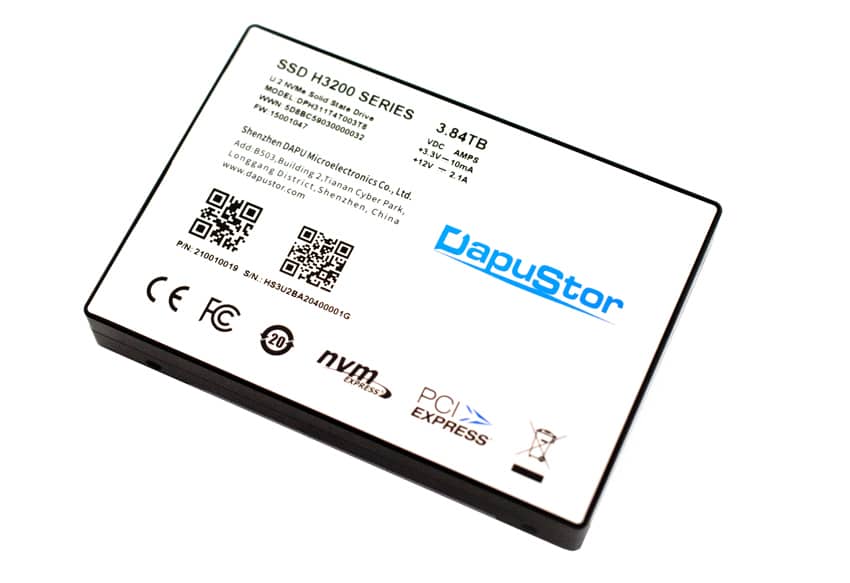
The H3200 is equipped with a range of features that focus on keeping data safe, such as end-to-end data protection on both Firmware and hardware path, including DDR ECC, LDPC, power loss protection. Performance-wise, the DapuStor H3200 is quoted to reach sequential speeds up to 3,578MB/s read and 2559MB/s write, while random 4k performance is expected to hit as high as 832,000 IOPS read and 101,000 IOPS write.
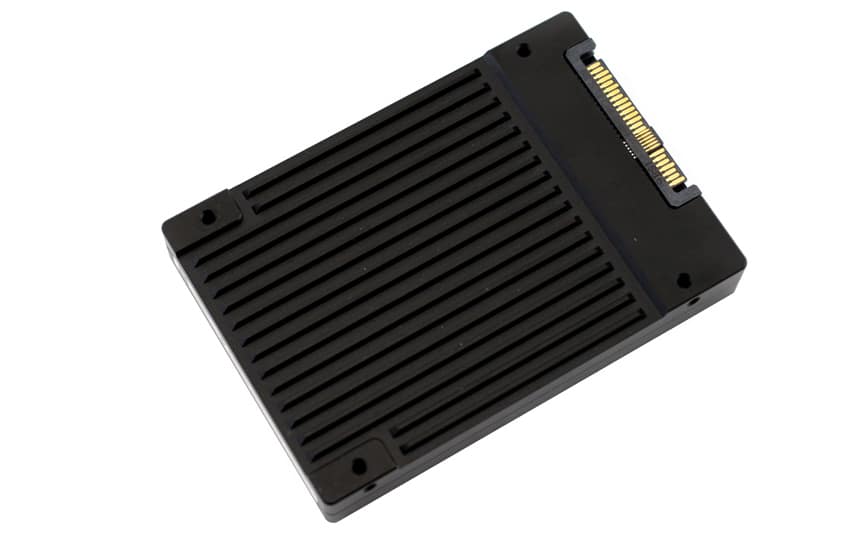
The DapuStor H3200 comes in capacities of 1TB, 1.92TB, 3.84TB and 7.58TB. We will be looking at the 3.84TB model for this review.
DapuStor H3200 Specifications
| Model No | H3200 | |||
| Capacity (TB1) | 0.96 | 1.92 | 3.84 | 7.68 |
| Outline | U.2 & HHHL | |||
| Interface Protocol | PCIe3.0 x 4 NVMe 1.3 | |||
| Flash Type | 96L 3D eTLC NAND | |||
| Read Bandwidth (128KB) MB/s | 3527 | 3521 | 3577 | 3578 |
| Write Bandwidth (128KB) MB/s | 1322 | 2499 | 2570 | 2559 |
| Random Read (4KB) KIOPS | 562 | 805 | 830 | 832 |
| Random Write (4KB) KIOPS | 52 | 108 | 121 | 101 |
| Power Consumption | 7.0/8.5 | 8.0/9.5 | 8.5/10.5 | 8.5/11.5 |
| 4K Random Latency (Typ.) R/W μs | 86/17 | |||
| 4K Sequential Latency (Typ.) R/W μs | 15/17 | |||
| Lifespan | 1 DWPD | |||
| Uncorrectable Bit Error Rate (UBER) | <10-17 | |||
| Mean Time Between Failure (MTBF) | 2 million hours | |||
| Supported OS | RHEL, SLES, CentOS, Ubuntu, Windows Server, VMware ESXi | |||
| Certification | FCC, CE, ROHS, REACH, WEEE, PCI express, NVM express | |||
DapuStor Haishen3 H3200 Performance
Testbed
Our Enterprise SSD reviews leverage a Lenovo ThinkSystem SR850 for application tests (Note: we had to use an adapter card instead of a front bay slot due to a compatibility issue) and a Dell PowerEdge R740xd for synthetic benchmarks. The ThinkSystem SR850 is a well-equipped quad-CPU platform, offering CPU power well in excess of what’s needed to stress high-performance local storage. Synthetic tests that don’t require a lot of CPU resources use the more traditional dual-processor server. In both cases, the intent is to showcase local storage in the best light possible that aligns with storage vendor maximum drive specs.
Lenovo ThinkSystem SR850
- 4 x Intel Platinum 8160 CPU (2.1GHz x 24 Cores)
- 16 x 32GB DDR4-2666Mhz ECC DRAM
- 2 x RAID 930-8i 12Gb/s RAID Cards
- 8 NVMe Bays
- VMware ESXI 6.5
Dell PowerEdge R740xd
- 2 x Intel Gold 6130 CPU (2.1GHz x 16 Cores)
- 4 x 16GB DDR4-2666MHz ECC DRAM
- 1x PERC 730 2GB 12Gb/s RAID Card
- Add-in NVMe Adapter
- Ubuntu-16.04.3-desktop-amd64
Testing Background and Comparables
The StorageReview Enterprise Test Lab provides a flexible architecture for conducting benchmarks of enterprise storage devices in an environment comparable to what administrators encounter in real deployments. The Enterprise Test Lab incorporates a variety of servers, networking, power conditioning, and other network infrastructure that allows our staff to establish real-world conditions to accurately gauge performance during our reviews.
We incorporate these details about the lab environment and protocols into reviews so that IT professionals and those responsible for storage acquisition can understand the conditions under which we have achieved the following results. None of our reviews are paid for or overseen by the manufacturer of equipment we are testing. Additional details about the StorageReview Enterprise Test Lab and an overview of its networking capabilities are available on those respective pages.
Application Workload Analysis
In order to understand the performance characteristics of enterprise storage devices, it is essential to model the infrastructure and the application workloads found in live-production environments. Our benchmarks for the DapuStor H3200 are therefore the MySQL OLTP performance via SysBench and Microsoft SQL Server OLTP performance with a simulated TCP-C workload. For our application workloads, each drive will be running 2-4 identically configured VMs.
Houdini by SideFX
The Houdini test is specifically designed to evaluate storage performance as it relates to CGI rendering. The test bed for this application is a variant of the core Dell PowerEdge R740xd server type we use in the lab with dual Intel 6130 CPUs and 64GB DRAM. In this case, we installed Ubuntu Desktop (ubuntu-16.04.3-desktop-amd64) running bare metal. Output of the benchmark is measured in seconds to complete, with fewer being better.
The Maelstrom demo represents a section of the rendering pipeline that highlights the performance capabilities of storage by demonstrating its ability to effectively use the swap file as a form of extended memory. The test does not write out the result data or process the points in order to isolate the wall-time effect of the latency impact to the underlying storage component. The test itself is composed of five phases, three of which we run as part of the benchmark, which are as follows:
- Loads packed points from disk. This is the time to read from disk. This is single threaded, which may limit overall throughput.
- Unpacks the points into a single flat array in order to allow them to be processed. If the points do not have dependency on other points, the working set could be adjusted to stay in-core. This step is multi-threaded.
- (Not Run) Processes the points.
- Repacks them into bucketed blocks suitable for storing back to disk. This step is multi-threaded.
- (Not Run) Writes the bucketed blocks back out to disk.
Here, the DapuStor H3200 performed well with 2,733 seconds, placing it in the upper-mid part of the leaderboard just behind the Samsung EVO Plus.
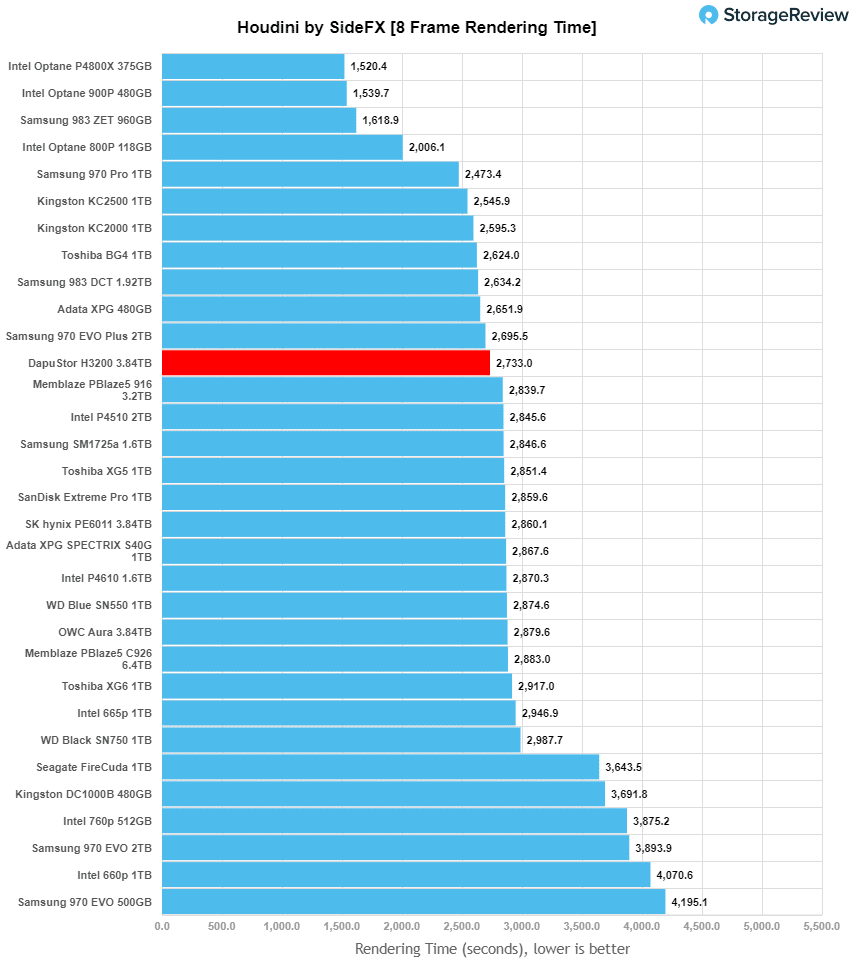
SQL Server Performance
Each SQL Server VM is configured with two vDisks: 100GB volume for boot and a 500GB volume for the database and log files. From a system-resource perspective, we configured each VM with 16 vCPUs, 64GB of DRAM and leveraged the LSI Logic SAS SCSI controller. While our Sysbench workloads tested previously saturated the platform in both storage I/O and capacity, the SQL test is looking for latency performance.
This test uses SQL Server 2014 running on Windows Server 2012 R2 guest VMs, and is stressed by Quest’s Benchmark Factory for Databases. StorageReview’s Microsoft SQL Server OLTP testing protocol employs the current draft of the Transaction Processing Performance Council’s Benchmark C (TPC-C), an online transaction-processing benchmark that simulates the activities found in complex application environments. The TPC-C benchmark comes closer than synthetic performance benchmarks to gauging the performance strengths and bottlenecks of storage infrastructure in database environments. Each instance of our SQL Server VM for this review uses a 333GB (1,500 scale) SQL Server database and measures the transactional performance and latency under a load of 15,000 virtual users.
SQL Server Testing Configuration (per VM)
- Windows Server 2012 R2
- Storage Footprint: 600GB allocated, 500GB used
- SQL Server 2014
-
- Database Size: 1,500 scale
- Virtual Client Load: 15,000
- RAM Buffer: 48GB
- Test Length: 3 hours
- 2.5 hours preconditioning
- 30 minutes sample period
For our SQL Server transactional benchmark, the DapuStor H3200 had a score of 12,323.6 TPS at 4VMs.
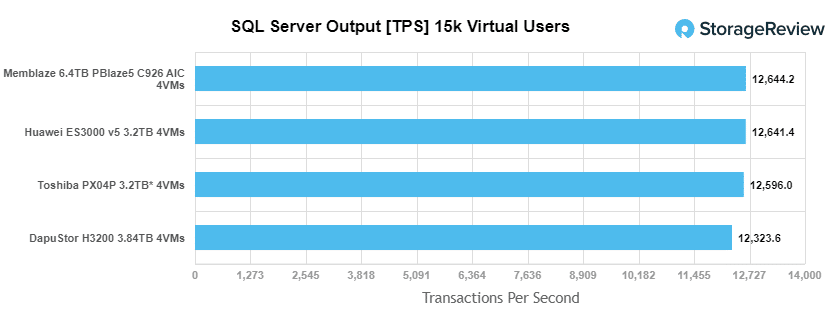
In average latency, the DapuStor H3200 showed 126.5ms, which was significantly higher than the other tested drives.
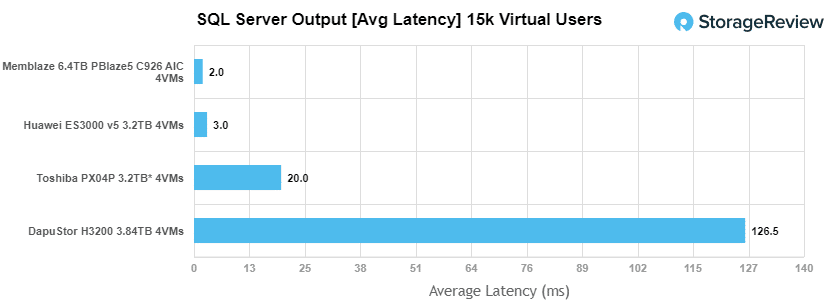
Sysbench Performance
The next application benchmark consists of a Percona MySQL OLTP database measured via SysBench. This test measures average TPS (Transactions Per Second), average latency, and average 99th percentile latency as well.
Each Sysbench VM is configured with three vDisks: one for boot (~92GB), one with the pre-built database (~447GB), and the third for the database under test (270GB). From a system-resource perspective, we configured each VM with 16 vCPUs, 60GB of DRAM and leveraged the LSI Logic SAS SCSI controller.
Sysbench Testing Configuration (per VM)
- CentOS 6.3 64-bit
- Percona XtraDB 5.5.30-rel30.1
-
- Database Tables: 100
- Database Size: 10,000,000
- Database Threads: 32
- RAM Buffer: 24GB
- Test Length: 3 hours
- 2 hours preconditioning 32 threads
- 1 hour 32 threads
Looking at our Sysbench transactional benchmark, the DapuStor H3200 posted an aggregate score of 7,879.1 TPS, placing it in the middle of the leaderboard.
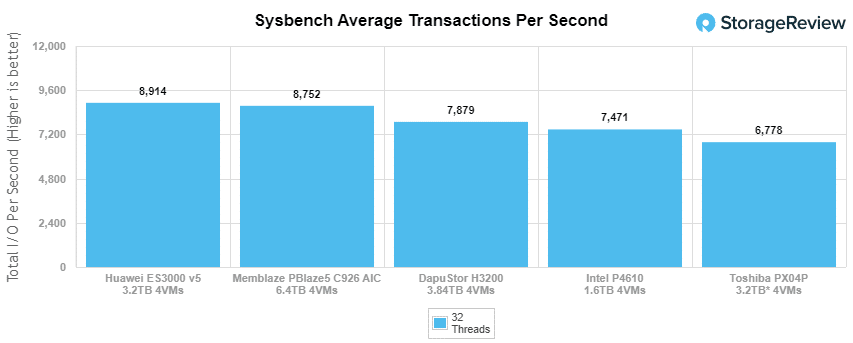 Sysbench average latency saw the H3200 with a latency of 16.25ms, right in the middle of the pack.
Sysbench average latency saw the H3200 with a latency of 16.25ms, right in the middle of the pack.
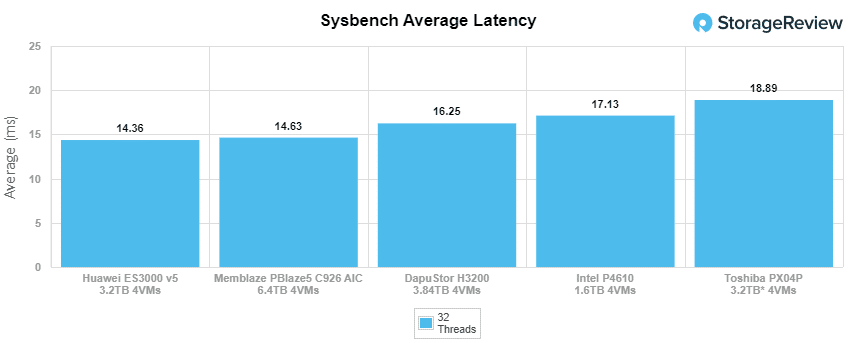
For our worst-case scenario latency (99th percentile) the H3200 a latency of 31.12, which was right in the middle of the other two comparables.
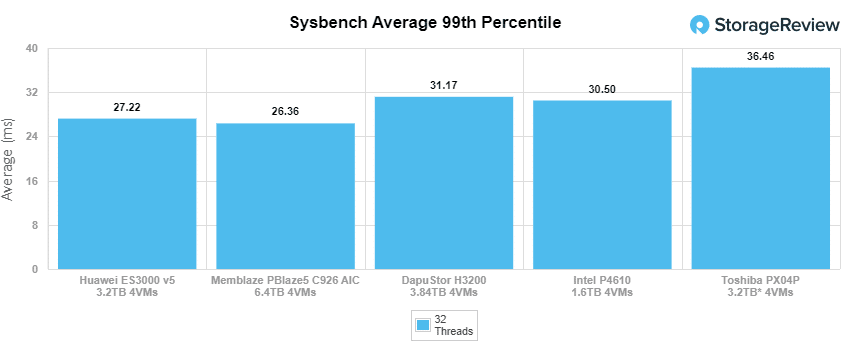
VDBench Workload Analysis
When it comes to benchmarking storage devices, application testing is best, and synthetic testing comes in second place. While not a perfect representation of actual workloads, synthetic tests do help to baseline storage devices with a repeatability factor that makes it easy to do apples-to-apples comparison between competing solutions. These workloads offer a range of different testing profiles ranging from “four corners” tests, common database transfer size tests, to trace captures from different VDI environments. All of these tests leverage the common vdBench workload generator, with a scripting engine to automate and capture results over a large compute testing cluster. This allows us to repeat the same workloads across a wide range of storage devices, including flash arrays and individual storage devices. Our testing process for these benchmarks fills the entire drive surface with data, then partitions a drive section equal to 25% of the drive capacity to simulate how the drive might respond to application workloads. This is different than full entropy tests which use 100% of the drive and takes them into steady state. As a result, these figures will reflect higher-sustained write speeds.
Profiles:
- 4K Random Read: 100% Read, 128 threads, 0-120% iorate
- 4K Random Write: 100% Write, 64 threads, 0-120% iorate
- 64K Sequential Read: 100% Read, 16 threads, 0-120% iorate
- 64K Sequential Write: 100% Write, 8 threads, 0-120% iorate
- Synthetic Database: SQL and Oracle
- VDI Full Clone and Linked Clone Traces
Comparables:
In our first VDBench Workload Analysis, Random 4K Read, the H3200 had a solid peak score of 788,014 IOPS with a latency of 158.3µs, which was near the top of the pack.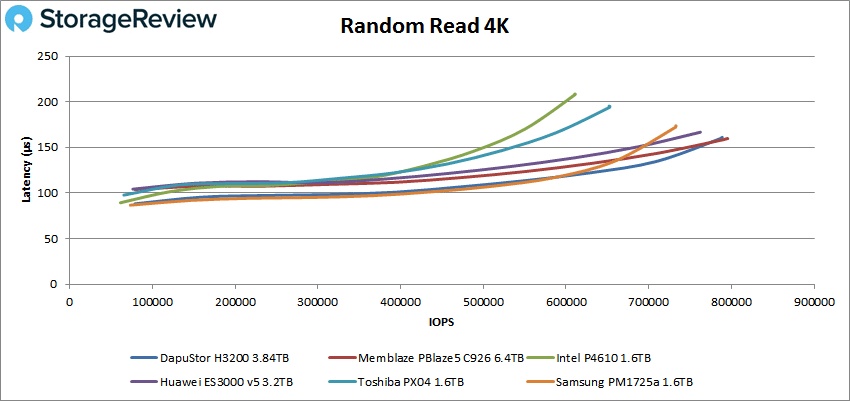 For 4K random write, the H3200 reached 274,362 IOPS at a latency of 462µs, taking a huge dip in performance around the 240K mark.
For 4K random write, the H3200 reached 274,362 IOPS at a latency of 462µs, taking a huge dip in performance around the 240K mark.
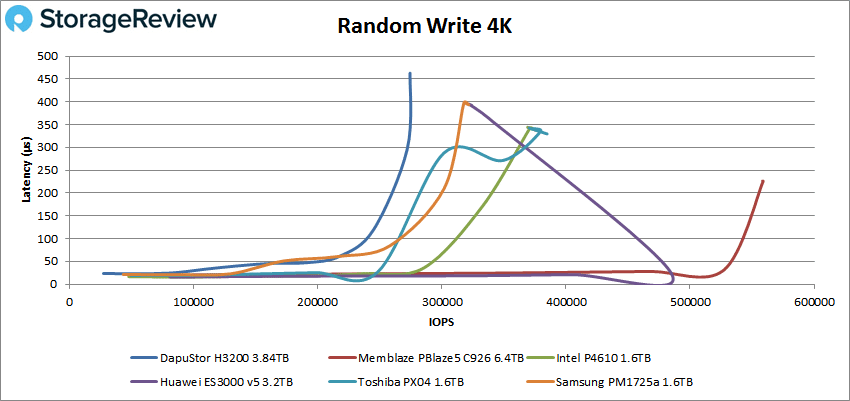 Switching over to 64k sequential workloads, the H3200 showed great results with a peak performance of 52,860 IOPS (or 3.3GB/s) with a latency of 301.8ms.
Switching over to 64k sequential workloads, the H3200 showed great results with a peak performance of 52,860 IOPS (or 3.3GB/s) with a latency of 301.8ms.
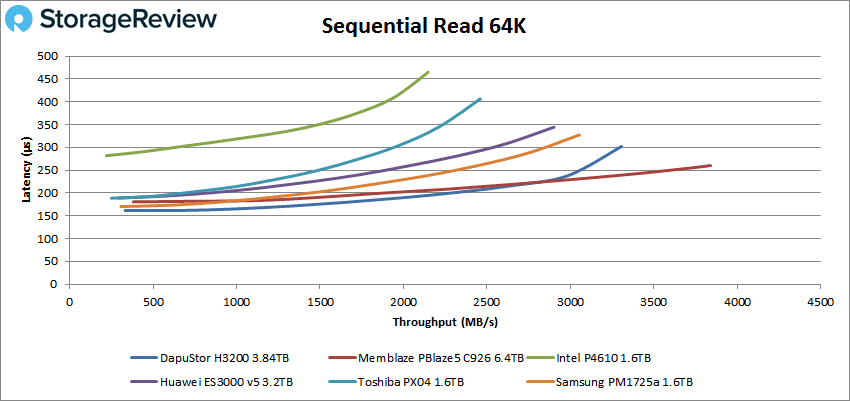 In 64k write, though the DapuStor H3200 3.84TB SSD found itself at the bottom of the leaderboard, hitting 22,200 IOPS (or 1.4GB/s) and 708ms, the latter which was by far among the highest latency scores (just below the Samsung drive).
In 64k write, though the DapuStor H3200 3.84TB SSD found itself at the bottom of the leaderboard, hitting 22,200 IOPS (or 1.4GB/s) and 708ms, the latter which was by far among the highest latency scores (just below the Samsung drive).
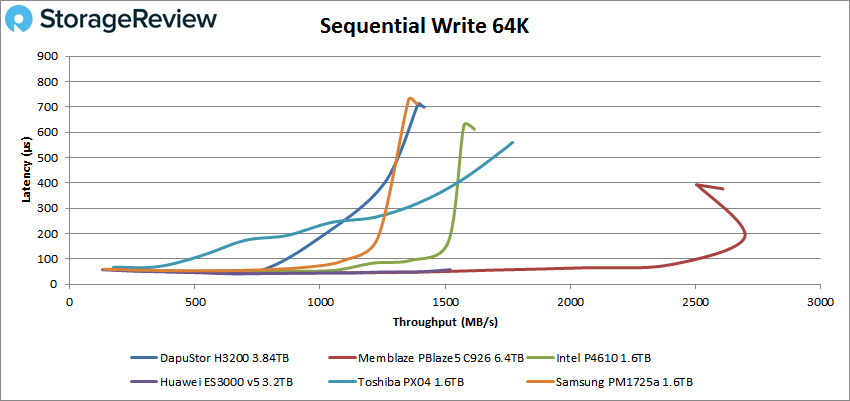
Our next set of tests are our SQL workloads: SQL, SQL 90-10, and SQL 80-20. Starting with SQL, the DapuStor H3200 was by far the best-tested drive throughout the test, where it peaked at 281,512 IOPS with a latency of just 113.2µs.
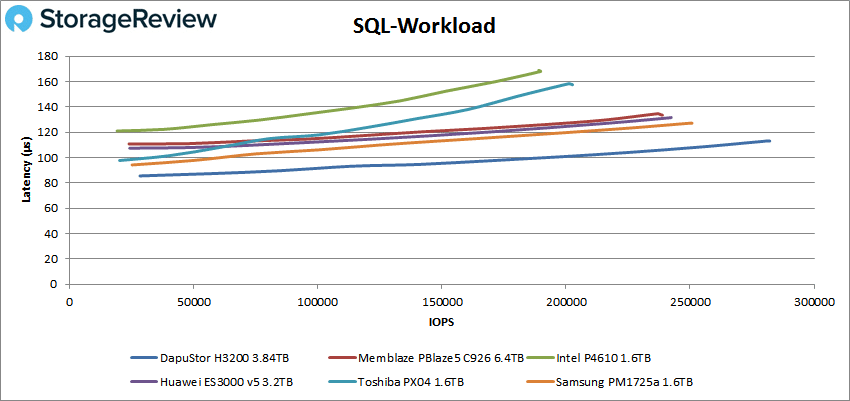 In SQL 80-20, the H3200 again showed great performance with a peak of 246,601 IOPS and 128.4µs .
In SQL 80-20, the H3200 again showed great performance with a peak of 246,601 IOPS and 128.4µs .
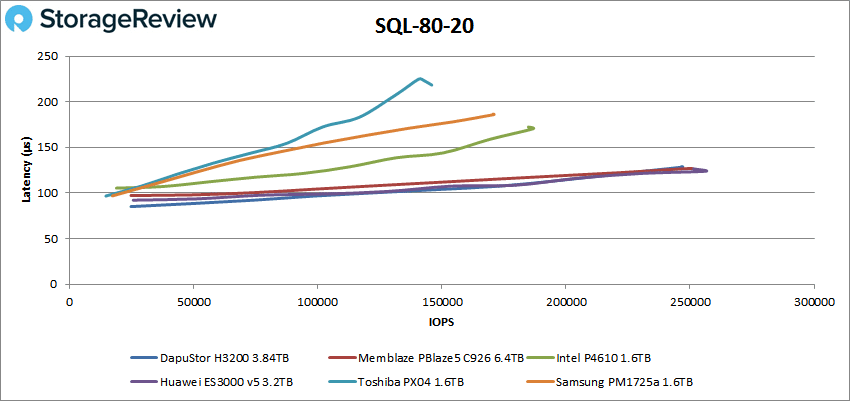 With the SQL 90-10, the H3200 continued to show impressive performance, peaking at 269,251 IOPS with a latency 118.2µs for top spot.
With the SQL 90-10, the H3200 continued to show impressive performance, peaking at 269,251 IOPS with a latency 118.2µs for top spot.
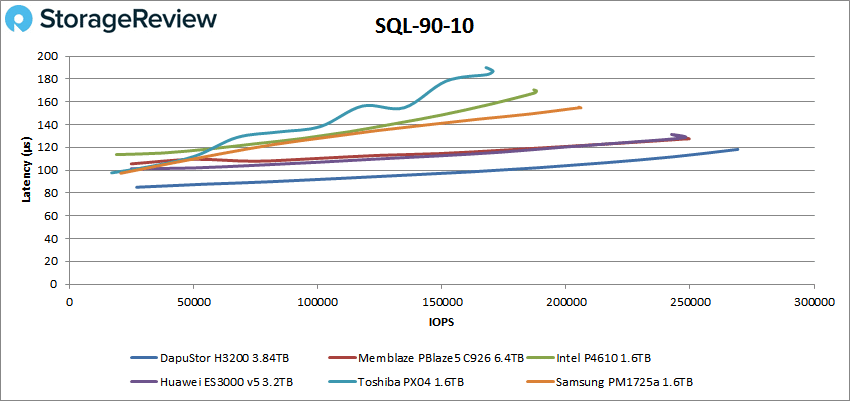 Next up are our Oracle workloads: Oracle, Oracle 90-10, and Oracle 80-20. Starting with Oracle, the DapuStor H3200 peaked with 232,468 IOPS with a latency of 154.7µs, which was good enough for 3rd overall.
Next up are our Oracle workloads: Oracle, Oracle 90-10, and Oracle 80-20. Starting with Oracle, the DapuStor H3200 peaked with 232,468 IOPS with a latency of 154.7µs, which was good enough for 3rd overall.
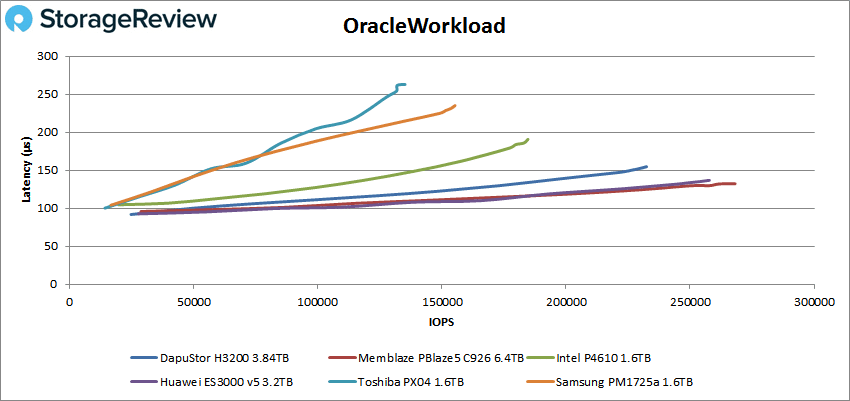 Oracle 90-10 showed us more of the above, the DapuStor H3200 moved back into first with a top performance of 214,076 IOPS at 102.1µs.
Oracle 90-10 showed us more of the above, the DapuStor H3200 moved back into first with a top performance of 214,076 IOPS at 102.1µs.
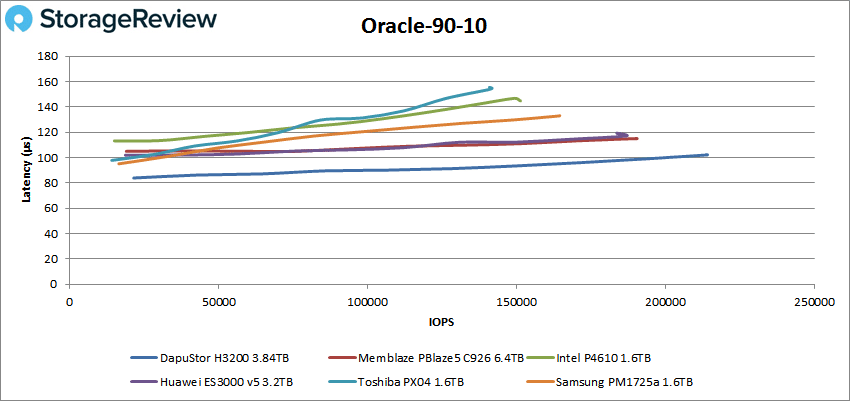 With Oracle 80-20, the H3200 was the top performer again, peaking at 204,281 IOPS with a latency of 107.1µs.
With Oracle 80-20, the H3200 was the top performer again, peaking at 204,281 IOPS with a latency of 107.1µs.
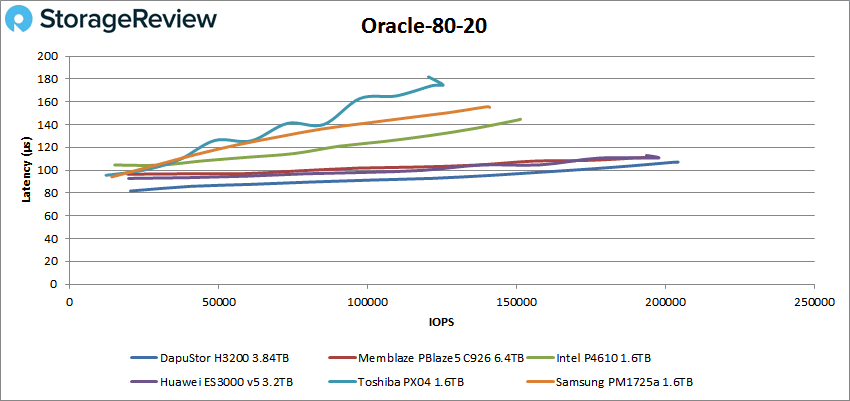
Next, we switched over to our VDI clone test, Full and Linked. For VDI Full Clone (FC) Boot, the DapuStor H3200 had a peak of 188,260 IOPS at a latency of 183.3µs behind only the Memblaze.
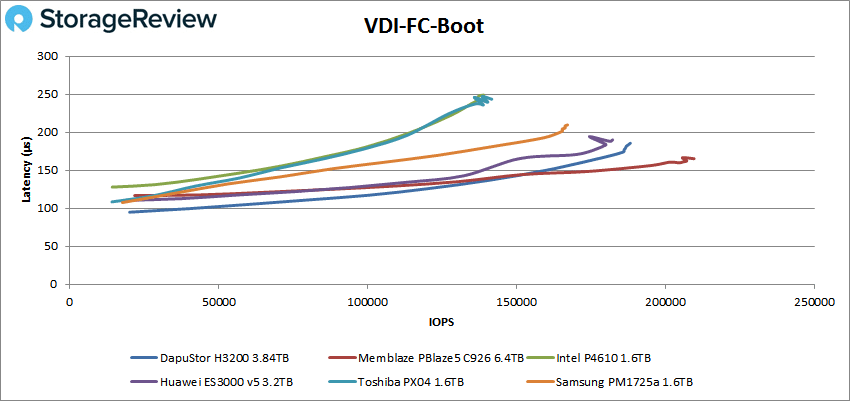 VDI FC Initial Login saw the DapuStor H3200 peak at 81,510 IOPS with a latency of 363.9µs, this time well behind the Memblaze and Huawei drives.
VDI FC Initial Login saw the DapuStor H3200 peak at 81,510 IOPS with a latency of 363.9µs, this time well behind the Memblaze and Huawei drives.
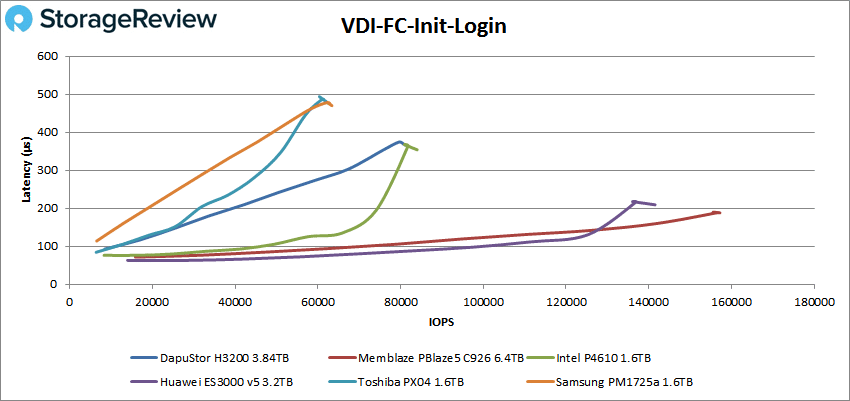 For VDI FC Monday Login, the DapuStor H3200 peaked at 68,280 IOPS at a latency of 232.8µs, again well back of the leaders.
For VDI FC Monday Login, the DapuStor H3200 peaked at 68,280 IOPS at a latency of 232.8µs, again well back of the leaders.
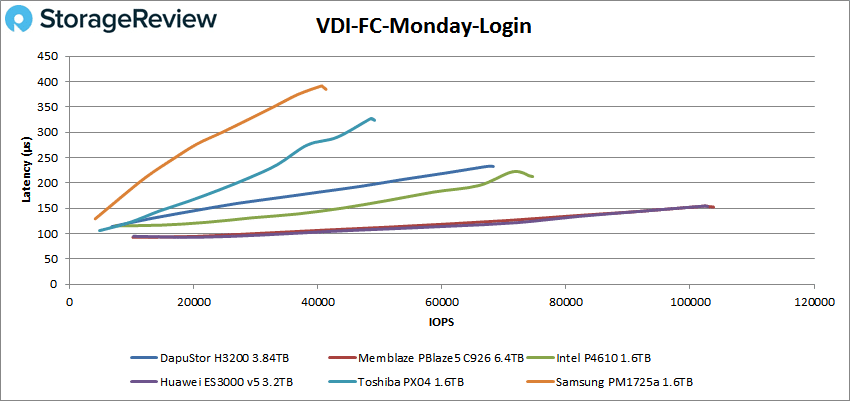 For VDI Linked Clone (LC) Boot, the DapuStor H3200 placed second with a peak score of 93,152 IOPS with a latency of 171.2µs.
For VDI Linked Clone (LC) Boot, the DapuStor H3200 placed second with a peak score of 93,152 IOPS with a latency of 171.2µs.
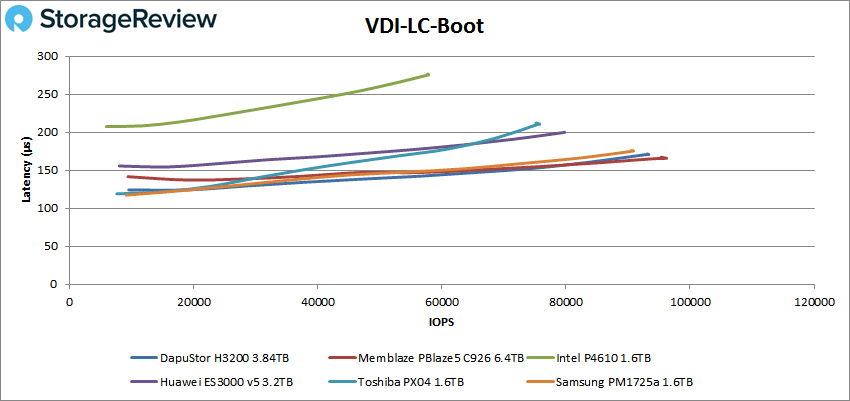 VDI LC Initial Login showed a peak score of 40,228 IOPS at a latency of 196.6µs, showing very similar performance as the Intel P4610 drive.
VDI LC Initial Login showed a peak score of 40,228 IOPS at a latency of 196.6µs, showing very similar performance as the Intel P4610 drive.
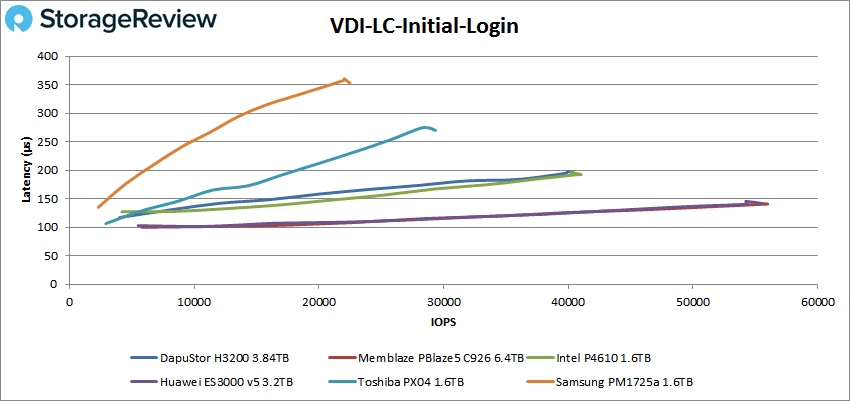 Lastly, with VDI LC Monday Login, DapuStor H3200 showed mid-range performance with 50,330 IOPS with a latency of 315.3µs.
Lastly, with VDI LC Monday Login, DapuStor H3200 showed mid-range performance with 50,330 IOPS with a latency of 315.3µs.
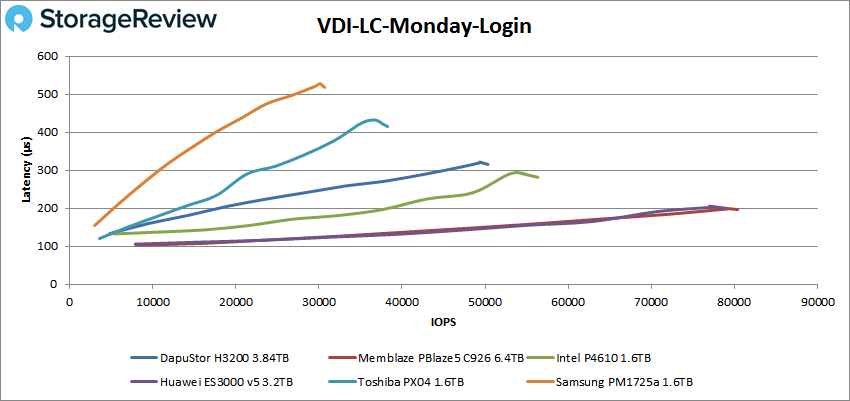 Conclusion
Conclusion
The DapuStor H3200 is the company’s latest NVMe SSD that features 96-layer 3D eTLC NAND, which is further sub-divided into two different categories, the U.2 and HHHL form factors. Powered by a Marvell controller, the H3200 also comes in a range of high-capacity models including 960GB, 1.92TB, 3.84TB and even 7.68TB, allowing for a variety of flexible deployment options to keep costs down.
During our tests, we compared the drive to a range of other SSDs, including the Memblaze PBlaze C926, the Huawei ES3000, and the Intel P4610. For Application Workload Analysis, we saw the DapuStor H3200 hit 12,323.6 TPS at 4VMs 126.5ms in average latency, which was significantly higher than the other tested drives. For Sysbench, the drive hit 7,879.1 TPS, 16.25ms average latency, and 31.23ms worst-case scenario latency, all of which were mid-range performance.
During our VDbench test, highlights included: 788,014 IOPS in 4K read, 274,362 IOPS in 4K write, 3.3GB/s in 64K read, and 1.4GB/s in 64K write. In SQL workloads, it hit 281,512 IOPS while hitting 269,251 IOPS for SQL 90-10, and 246,601 IOPS for SQL 80-20, placing it at the top of the leader board in all three categories. The DapuStor continued its solid performance in Oracle workloads with 232,468 IOPS, 214,076 IOPS in Oracle 90-10, and 204,281 IOPS in Oracle 80-20. In our VDI Full Clone tests, the H3200 hit 188,260 IOPS (boot), 81,510 IOPS (initial login), 68,280 IOPS (Monday login), while Linked Clone posted 93,152 IOPS (boot) 40,228 IOPS (initial login), and 50,330 IOPS (Monday login).
Overall, the DapuStor H3200 was a bit uneven in performance: it was solid during our synthetic tests but performed behind the pack in the SQL Server application workload.
Engage with StorageReview
Newsletter | YouTube | Podcast iTunes/Spotify | Instagram | Twitter | Facebook | RSS Feed
